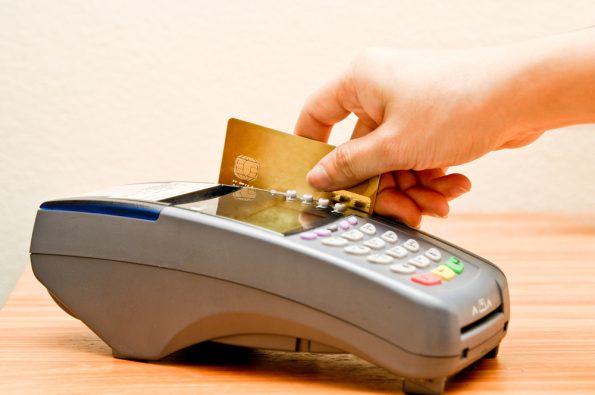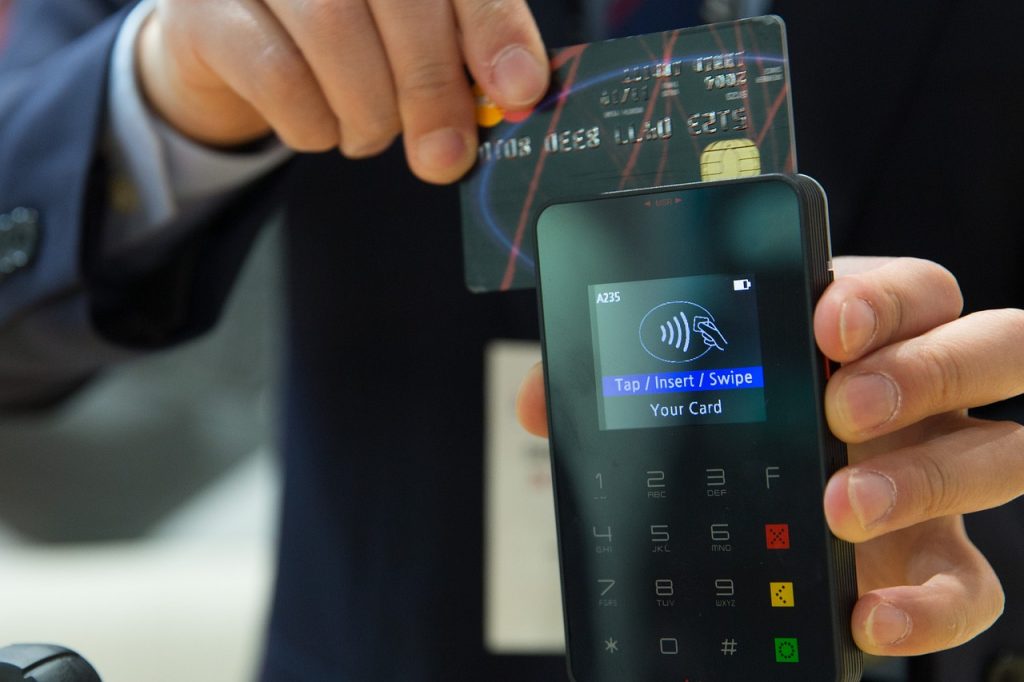Credit Card Payments: Proactively Manage High Risk Designations and Chargebacks
Has your business been designated as “high-risk” by a credit card processor? Unfortunately, many companies are designated as high-risk, which could lead to a host of problems. In a worst-case scenario, you might be denied or lose your merchant account. All companies, especially startups, should take risk management seriously and be proactive in minimizing the time and risk of getting paid.

payment machine and Credit card in supermarket
Ultimately, credit card processing can be high-risk, and processors often prefer to work with low-risk businesses. A business can be labeled high-risk for a variety of reasons including operating within a high-risk industry or suffering from volatile revenues.
Processors that do take on high risk do so with increased fees, higher rates, and required rolling reserves. This can create headaches for businesses big and small. Let’s look at some steps you can take to mitigate the risks associated with high-risk accounts and also how you can cope with a high risk designation.
What is High Risk Anyway?
In order to accept credit card payments, you have to work with credit card processors, who usually charge a per-transaction fee and also a percentage rate of the sale. Credit card processors may apply a “high-risk” to your company if you operate in certain industries, you have a poor credit history, or certain other conditions qualify you.
One major concern for credit card processors are “card not present” transactions. These days, you can process payments when a credit card is not physically present. Most online credit card purchases are “card not present” transactions since you never see the physical card. Since the card isn’t present, risks increase.
In order to offset risks, the processor may charge you higher fees or force you set aside reserves (more on this later). And if you process too much fraud or suffer too many chargebacks, you may quickly run into liquidity issues. In a worse-case scenario, your business may even end up going under.
High-Risk Merchant Accounts Explained
Another risk management lesson is that, generally, high-risk businesses have greater exposure to fraud and chargebacks. A chargeback occurs when customers go to their issuing banks to refund the purchase that they feel is problematic or perhaps fraudulent. If the chargeback is approved, the issuing bank will essentially take money back from you.
Sometimes, chargebacks are legitimate, a customer may have never received goods ordered online, for example. Yet some unscrupulous customers may try to use chargebacks to essentially steal the product. They received the goods they legitimately ordered, but they don’t want to pay for them.
Either way, if your business frequently suffers chargebacks, it costs you and your processor. For this reason, they may designate you as high risk, requiring a high-risk merchant account. On the other hand, if chargebacks are rarely a problem, and your business has a good credit history, you may be granted a standard merchant account.
However, many businesses, including those with a good credit history, end up designated as high risk simply because they operate in a certain industry. For various reasons, payment processors can designate an industry as high risk, and they may classify any business operating in said industry as high risk.
High-Risk Industries
Some industries simply present greater risks than others for credit card payment processors. If your business operates in such an industry, you will almost certainly be designated as high risk. Some high-risk industries include:
- Online gaming and gambling
- Adult services
- Consumer electronics
- Health & Fitness
- Legal services
- Pharmaceuticals
- Travel
The above list is not exhaustive. Any industry with statistically high fraud rates as high-risk. For example, businesses working in the marijuana industry, which in the US exists in a legal gray zone, are classified as high-risk. Likewise, billing models prone to fraud and disputes, such as subscription billing, get the high-risk designation.
What High-Risk Designation Means for You
Unfortunately, your business could end up with a high-risk designation. Part of this designation may be due to your industry. However, just about any business can end up designated as high-risk, including those working in lower risk industries. If your company has a poor credit history, has suffered a large number of chargebacks, or otherwise has an increased risk profile, a processor will designate you as high risk.
If you’re deemed “high-risk”, you’ll suffer various adverse consequences, including:
- Increased fees: Often, high-risk businesses are subject to higher fees than their lower risk counterparts. You may suffer increased setup fees, payment gateway fees, chargeback fees, and more. Higher expenses can eat into your profit margin and make it difficult to keep your business afloat.
- Rolling reserve: Sometimes, a payment processor will set aside a portion of your daily payments and will only release payment after time has elapsed. The higher risk your business, the more a credit card payment processor may set aside. A typical rolling reserve requires 10% of your transactions for 90 days before releasing the payment to you. Obviously, this can cause cashflow problems even if you ultimately get your money.
- Minimum reserve: Similar to a rolling reserve, you may be required to set aside a minimum amount of cash at all times, meaning the payments are not released until the reserve is met. This is generally set as a lump sum deposit or as a percentage of transactions over time. For example, you may need to put $10,000 worth of transactions into a reserve account before payments are released. You’re required to constantly maintain this reserve.
In many cases, you can mitigate the risks of a high-risk designation by being proactive. For example, managing chargebacks by using the right chargeback tools and automating processes for handling them, can reduce chargebacks and improve revenues.
Effective Risk Management and Fighting Chargebacks
Managing chargebacks is now a vital risk management challenge for businesses big and small. Dispute management platforms, such as ChargebackHelp Plus
, can help you intercept disputes before they become chargebacks. This helps ensure you earn your rightful revenues and will also help mitigate the costs associated with a high-risk designation.
Your risk management goal should be to keep chargebacks below 1% of all purchases. If you exceed the ratio over a period of time, you can lose your ability to process credit cards with any processor.
So how do you put your company in a good position? Let’s take a look.
- Make sure your return policy is clear: First, you should offer customers an easy to understand and expedient return policy. This will encourage customers to use your return method rather than trying to secure a chargeback.
- Consider signed shipping: If you’re mailing physical goods, it’s smart to require a signature. This helps ensure that customers get their products and provides evidence that they did receive their goods.
- Set aside capital: It’s smart to set aside a good amount of liquid capital. This will help smooth over revenues, allow you to process returns, and otherwise ensure you’re in good financial shape.
- Look for the right payment processors: You can also find payment processors that specialize in your industry. These companies may offer better rates and overall better service.
- Manage your disputes proactively: Dispute alert companies like Ethoca and Verifi can send you alerts on pending chargebacks from different issuing banks. For the most part, Verifi covers Visa transactions, and Ethoca covers Mastercard. Merging chargeback alerts from these companies to catch all disputes will help keep your chargeback ratio safe.
If a chargeback occurs, your chargeback management platform can alert you to take action. From there, you can refund the dispute to avoid the chargeback. If you feel the dispute is illegitimate, you can fight the chargeback, and prove that the customer did indeed receive products. But even if you win, the chargeback gets recorded to your ratio.
Chargeback management platforms can also configure Ethoca and Verifi products to send proof of purchase up-front, before a dispute so the cardholder better recognizes their purchase. The more evidence you have linking a customer to a legitimate purchase, the better.
Some platforms can automate much of this for you, freeing you up to focus on other more important areas of your business.
Managing chargebacks can be a bit of a pain. However, the right chargeback management tools will make the whole process easier to handle. This way, you’ll spend less time dealing with them and can effectively fight or manage more chargebacks.
Be Proactive and Take Control of Risks
Ultimately, risk management, including reducing chargebacks, is extremely important for high-risk merchants. Your business depends on it. By effectively managing chargebacks, you can reduce the pains caused by a high-risk designation. Put your company in a position to succeed by managing your risk profile and reducing the risks associated with chargebacks.

